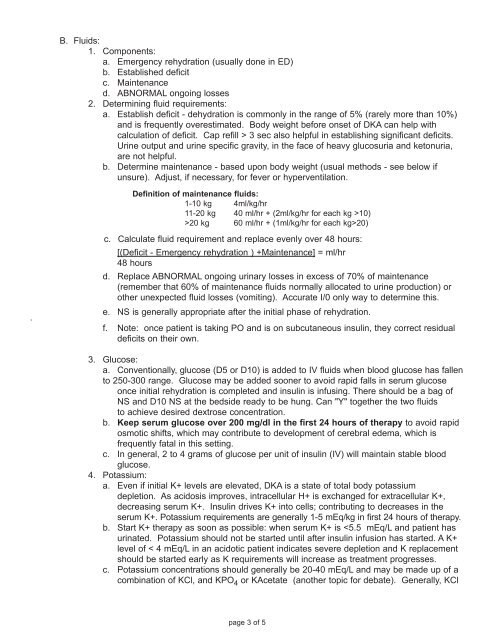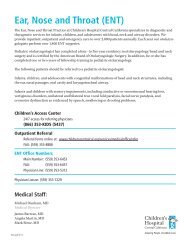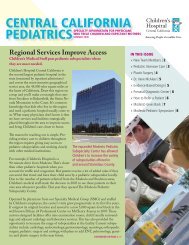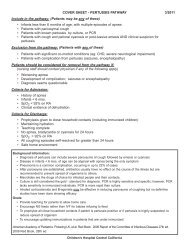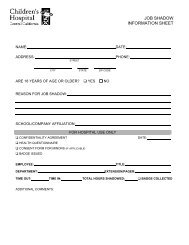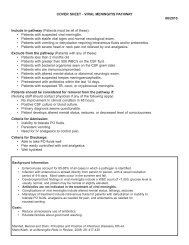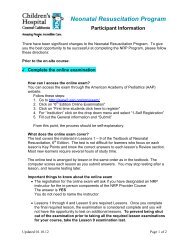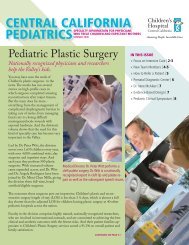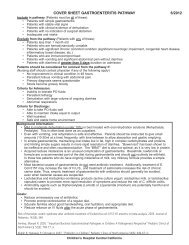Diabetic Ketoacidosis Pathway - Children's Hospital Central California
Diabetic Ketoacidosis Pathway - Children's Hospital Central California
Diabetic Ketoacidosis Pathway - Children's Hospital Central California
- No tags were found...
Create successful ePaper yourself
Turn your PDF publications into a flip-book with our unique Google optimized e-Paper software.
B. Fluids:1. Components:a. Emergency rehydration (usually done in ED)b. Established deficitc. Maintenanced. ABNORMAL ongoing losses2. Determining fluid requirements:a. Establish deficit - dehydration is commonly in the range of 5% (rarely more than 10%)and is frequently overestimated. Body weight before onset of DKA can help withcalculation of deficit. Cap refill > 3 sec also helpful in establishing significant deficits.Urine output and urine specific gravity, in the face of heavy glucosuria and ketonuria,are not helpful.b. Determine maintenance - based upon body weight (usual methods - see below ifunsure). Adjust, if necessary, for fever or hyperventilation.Definition of maintenance fluids:1-10 kg 4ml/kg/hr11-20 kg 40 ml/hr + (2ml/kg/hr for each kg >10)>20 kg 60 ml/hr + (1ml/kg/hr for each kg>20).c. Calculate fluid requirement and replace evenly over 48 hours:[(Deficit - Emergency rehydration ) +Maintenance] = ml/hr48 hoursd. Replace ABNORMAL ongoing urinary losses in excess of 70% of maintenance(remember that 60% of maintenance fluids normally allocated to urine production) orother unexpected fluid losses (vomiting). Accurate I/0 only way to determine this.e. NS is generally appropriate after the initial phase of rehydration.f. Note: once patient is taking PO and is on subcutaneous insulin, they correct residualdeficits on their own.3. Glucose:a. Conventionally, glucose (D5 or D10) is added to IV fluids when blood glucose has fallento 250-300 range. Glucose may be added sooner to avoid rapid falls in serum glucoseonce initial rehydration is completed and insulin is infusing. There should be a bag ofNS and D10 NS at the bedside ready to be hung. Can "Y" together the two fluidsto achieve desired dextrose concentration.b. Keep serum glucose over 200 mg/dl in the first 24 hours of therapy to avoid rapidosmotic shifts, which may contribute to development of cerebral edema, which isfrequently fatal in this setting.c. In general, 2 to 4 grams of glucose per unit of insulin (IV) will maintain stable bloodglucose.4. Potassium:a. Even if initial K+ levels are elevated, DKA is a state of total body potassiumdepletion. As acidosis improves, intracellular H+ is exchanged for extracellular K+,decreasing serum K+. Insulin drives K+ into cells; contributing to decreases in theserum K+. Potassium requirements are generally 1-5 mEq/kg in first 24 hours of therapy.b. Start K+ therapy as soon as possible: when serum K+ is


